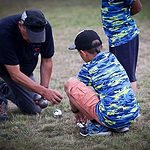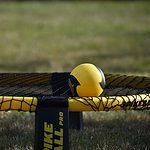Discover a collection of enjoyable and straightforward Spikeball techniques designed to elevate your gameplay experience.
Whether you're seeking to add a new dimension to your skills or simply looking to spice up your matches, these tricks cater to players of all levels.
From mastering deceptive moves to executing precise shots, each trick offers a unique challenge and opportunity for improvement.
Stay tuned to uncover how these fun and easy Spikeball tricks can take your game to the next level.
Key Takeaways
- Master serve and spike combos for strategic plays and precise timing.
- Execute quick hit and run plays with agility and speed for surprise advantage.
- Incorporate creative shots like behind-the-back and drop shots for stylish and unpredictable gameplay.
- Elevate intensity with fast-paced rallies and strategic angle bounce shots for a competitive edge.
Simple Serve and Spike Combo
To set up a successful serve and spike combo in Spikeball, strategic positioning and precise timing are key elements for catching your opponents off guard and scoring points. The serve initiates the rally, requiring accuracy and control to start the play effectively.
As the ball is served, players strategically position themselves to receive the ball and set up for the spike. Communication between teammates is crucial to coordinate the timing for the spike, ensuring a powerful and well-executed attack.
By mastering the serve and spike combo, you can surprise your opponents with quick and efficient plays, earning valuable points in the game. Practicing this fundamental combination not only enhances your gameplay skills but also strengthens teamwork and coordination with your partner.
Quick Hit and Run Play
Execute rapid hits and agile movements to master the dynamic and exciting Spikeball trick known as the Quick Hit and Run Play. This strategy involves quick strikes on the ball followed by swift movements to outmaneuver your opponents and create scoring opportunities.
To excel at this play, keep these tips in mind:
- Rapid Hits: Focus on hitting the ball onto the net swiftly to catch your opponents off guard. The element of surprise is key to gaining an advantage during the rally.
- Agile Movements: Use your speed and agility to move around the Spikeball net strategically. Quick footwork and sharp turns will help you stay ahead of your opponents.
- Varied Speed and Angle: Mix up the speed and angle of your hits to keep your opponents guessing. By changing your approach, you can maintain control of the rally and increase your chances of scoring points.
Sneaky Behind-the-Back Shot
Introduce a touch of finesse to your Spikeball gameplay with the crafty move known as the Sneaky Behind-the-Back Shot. This advanced trick involves hitting the ball behind your back, catching your opponents off guard and scoring points with style. To master this technique, you need precision and timing, making it a challenging yet rewarding addition to your gameplay arsenal.
| Sneaky Behind-the-Back Shot | |
|---|---|
| Description | Hit the ball behind your back |
| Execution | Requires precision and timing |
| Purpose | Surprise opponents and score points |
| Benefits | Adds creativity and unpredictability |
| Practice Tip | Enhance flair and style in gameplay |
Precision Drop Shot Technique
Enhance your Spikeball gameplay with the Precision Drop Shot Technique, a strategic move that requires finesse and precision to outsmart your opponents. Mastering this advanced technique involves softly hitting the ball just over the net with controlled finesse, catching your opponents off guard with subtlety and accuracy. Here's how you can perfect your precision drop shot:
- Subtle Touch: Develop a gentle touch to softly tap the ball over the net, making it challenging for your opponents to anticipate your moves.
- Timing and Control: Practice the drop shot consistently to improve your timing and control, ensuring that each shot is executed with precision.
- Unpredictability: By incorporating the precision drop shot into your strategy, you can introduce unpredictability into your gameplay, keeping your opponents on their toes and creating scoring opportunities.
Fast-Paced One-Touch Rally
Get ready to elevate your Spikeball game with the exhilarating challenge of the Fast-Paced One-Touch Rally.
In this exciting trick, players hit the ball back and forth over the Spikeball net with only one touch each. The key to mastering this rally is quick reactions and precise hits.
You need to stay focused and agile to maintain the rapid pace of the game.
The Fast-Paced One-Touch Rally aims to push your reflexes and control to the limit, keeping the ball in play at maximum speed.
Tricky Fakeout Move
Ready to take your Spikeball game to the next level? Master the art of the Tricky Fakeout Move to outwit your opponents with deceptive maneuvers and strategic plays. In this competitive game, the fakeout move can be a game-changer, catching your opponents off guard and opening up scoring opportunities for your team.
Here's how to perfect this tricky move:
- Deceive with Style: Use body feints or quick movements to make it seem like you're going one way, then quickly change direction to fake out your opponents.
- Timing is Key: To execute the fakeout move successfully, timing is crucial. Wait for the right moment when your opponents commit to a direction before pulling off your deceptive maneuver.
- Practice Makes Perfect: Incorporate the fakeout move into your training sessions to enhance your deception skills and overall gameplay strategies. The more you practice, the more confident and effective you'll become at tricking your opponents in the heat of a Spikeball match.
Dynamic Teamwork Maneuver
Mastering dynamic teamwork maneuvers in Spikeball requires quick communication and synchronized coordination between teammates to gain a competitive edge. In this fast-paced game, effective teamwork maneuvers are essential for success. By working together seamlessly, you and your teammate can anticipate each other's actions, positioning yourselves strategically to outsmart your opponents.
Clear communication is key; make sure to discuss roles and responsibilities beforehand to avoid confusion during gameplay. Trust and synergy between teammates are crucial for executing plays smoothly and efficiently. Stay adaptable, as the game can change in an instant, requiring you to adjust your strategies on the fly.
Creative Off-the-Body Hit
Unleash your creativity and surprise your opponents with the dynamic off-the-body hits in Spikeball, using unconventional body parts to keep them on their toes. Here are three tips to help you master this exciting technique:
- Experiment with Different Body Parts: Explore using your elbows, shoulders, knees, or even feet to hit the ball. Get comfortable with these unconventional hits to add a new dimension to your gameplay.
- Practice Trajectory and Timing: Understanding the trajectory of the ball and perfecting your timing is crucial for successful off-the-body hits. Practice different angles and forces to control where the ball goes.
- Incorporate Off-the-Body Hits Strategically: Use off-the-body hits strategically to confuse your opponents and create scoring opportunities. By mixing in these unexpected shots, you can keep your opponents guessing and gain an advantage on the Spikeball court.
Mastering off-the-body hits won't only showcase your creativity and versatility but also add an element of surprise to your Spikeball gameplay.
Strategic Angle Bounce Shot
To execute the strategic angle bounce shot effectively in Spikeball, aim the ball at an acute angle towards the net, requiring precise timing and control. This advanced trick adds a strategic element to your gameplay by creating challenging returns for your opponents.
By hitting the ball in such a way that it bounces sharply off the net, you can catch your opponents off guard and increase your chances of scoring points. Mastering this technique involves practicing different angles and ball speeds to find what works best for you.
The key to success lies in experimenting with the shot and honing your skills through repetition. When done correctly, the strategic angle bounce shot can be a game-changer, giving you an edge on the Spikeball court.
Show-Stopping Diving Save
If you're looking to showcase your agility and reflexes in Spikeball, mastering the show-stopping diving save can be a game-changer on the court. Here's how you can execute this impressive move:
- Quick Reaction: A diving save in Spikeball requires swift reflexes to respond to a low or hard-hit ball hurtling towards the ground. Anticipate the ball's trajectory and make your move decisively.
- Body Extension: To perform a successful diving save, extend your body horizontally towards the ball while keeping control. This full-body extension maximizes your reach and increases the chances of making contact with the ball.
- Timing and Precision: Timing is crucial when attempting a diving save. Execute the dive at the right moment to intercept the ball before it touches the ground. Precision in your movements can mean the difference between a spectacular save and a missed opportunity.
Mastering the diving save not only impresses those around you but also enhances your defensive skills, contributing to thrilling gameplay moments.





